The $60 CPU Question: AMD Athlon 200GE or Intel Pentium Gold G5400? A Review
by Ian Cutress on January 14, 2019 8:00 AM ESTCPU Performance: Encoding Tests
With the rise of streaming, vlogs, and video content as a whole, encoding and transcoding tests are becoming ever more important. Not only are more home users and gamers needing to convert video files into something more manageable, for streaming or archival purposes, but the servers that manage the output also manage around data and log files with compression and decompression. Our encoding tasks are focused around these important scenarios, with input from the community for the best implementation of real-world testing.
All of our benchmark results can also be found in our benchmark engine, Bench.
Handbrake 1.1.0: Streaming and Archival Video Transcoding
A popular open source tool, Handbrake is the anything-to-anything video conversion software that a number of people use as a reference point. The danger is always on version numbers and optimization, for example the latest versions of the software can take advantage of AVX-512 and OpenCL to accelerate certain types of transcoding and algorithms. The version we use here is a pure CPU play, with common transcoding variations.
We have split Handbrake up into several tests, using a Logitech C920 1080p60 native webcam recording (essentially a streamer recording), and convert them into two types of streaming formats and one for archival. The output settings used are:
- 720p60 at 6000 kbps constant bit rate, fast setting, high profile
- 1080p60 at 3500 kbps constant bit rate, faster setting, main profile
- 1080p60 HEVC at 3500 kbps variable bit rate, fast setting, main profile
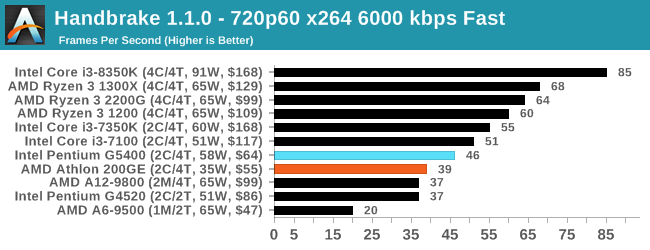
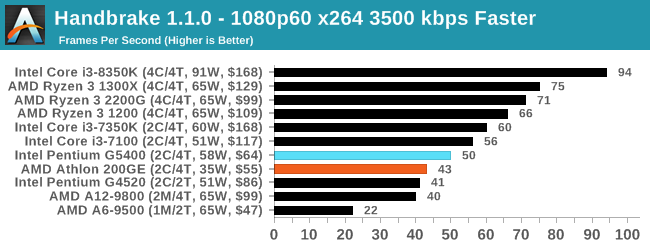
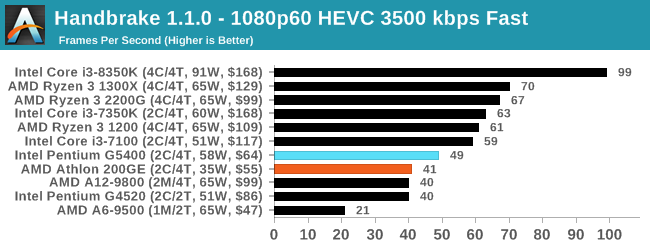
Handbrake manages to use the Pentium resources and higher frequency better, scoring about a 15% win in every circumstance.
7-zip v1805: Popular Open-Source Encoding Engine
Out of our compression/decompression tool tests, 7-zip is the most requested and comes with a built-in benchmark. For our test suite, we’ve pulled the latest version of the software and we run the benchmark from the command line, reporting the compression, decompression, and a combined score.
It is noted in this benchmark that the latest multi-die processors have very bi-modal performance between compression and decompression, performing well in one and badly in the other. There are also discussions around how the Windows Scheduler is implementing every thread. As we get more results, it will be interesting to see how this plays out.
Please note, if you plan to share out the Compression graph, please include the Decompression one. Otherwise you’re only presenting half a picture.
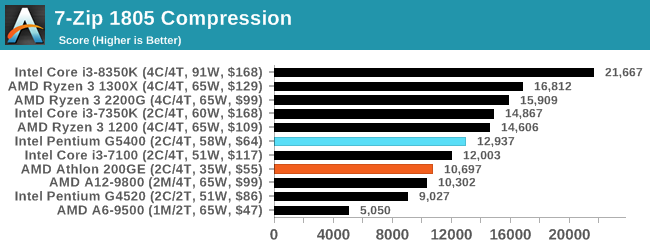
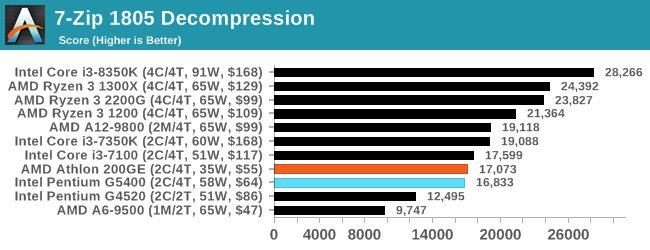
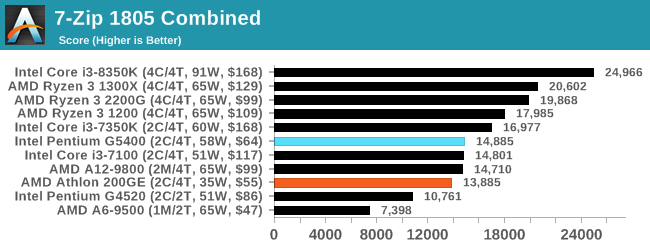
7-zip is an interesting test, given that Intel usually wins Compression but AMD wins Decompression. The same occurs here, however Intel wins the first test by a lot and AMD wins the second test by a small margin. Overall win to Intel here.
WinRAR 5.60b3: Archiving Tool
My compression tool of choice is often WinRAR, having been one of the first tools a number of my generation used over two decades ago. The interface has not changed much, although the integration with Windows right click commands is always a plus. It has no in-built test, so we run a compression over a set directory containing over thirty 60-second video files and 2000 small web-based files at a normal compression rate.
WinRAR is variable threaded but also susceptible to caching, so in our test we run it 10 times and take the average of the last five, leaving the test purely for raw CPU compute performance.
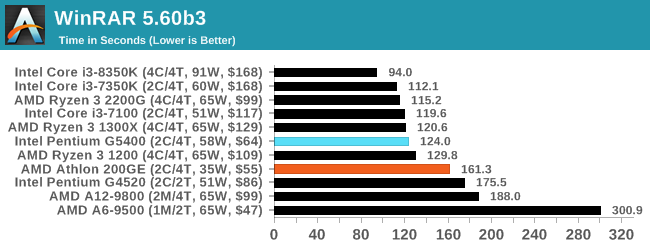
As a mixed workload that involves memory, this result would seem hard to predict given the two CPUs being tested. It ended up a clear win for Intel however – that extra core frequency in the G5400 mattered more than the main memory frequency of the 200GE.
AES Encryption: File Security
A number of platforms, particularly mobile devices, are now offering encryption by default with file systems in order to protect the contents. Windows based devices have these options as well, often applied by BitLocker or third-party software. In our AES encryption test, we used the discontinued TrueCrypt for its built-in benchmark, which tests several encryption algorithms directly in memory.
The data we take for this test is the combined AES encrypt/decrypt performance, measured in gigabytes per second. The software does use AES commands for processors that offer hardware selection, however not AVX-512.
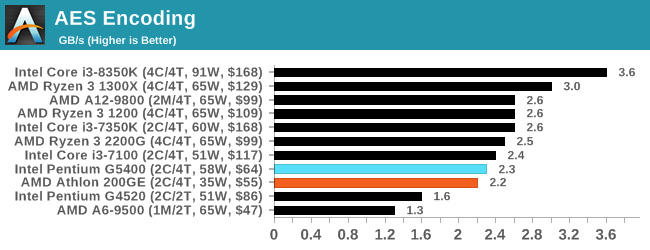










95 Comments
View All Comments
shabby - Tuesday, January 15, 2019 - link
Lol this chip hasn't been $60 for half a year, what was AT thinking writing this article? The intel bias is strong here.yannigr2 - Monday, January 14, 2019 - link
I stopped reading this article when I saw that the Pentium price is NOT based on the ACTUAL price of the processor in the market, but just some marketing/wishful thinking that Intel posts on it's site.Pity. I was expecting more from Anandtech.
mobutu - Monday, January 14, 2019 - link
"In gaming with a discrete graphics card, for example, if you've invested in something like the GTX 1080..."so we're talking about the absolute cheapest of the cheap build but all of the sudden "you invested in a GTX 1080" ?
megaLOL wtf is this
sing_electric - Monday, January 14, 2019 - link
Yeah, that sentence is weird (though I guess, if you have $400 now, you can get a working system with a very solid PSU and the rest of the specs listed here, and if you have money later, plop in a dGPU you actually want, and after that, get the CPU you actually want), but the reason to use a GTX 1080 in the test is that you can be more or less guaranteed that none of the scores you saw were GPU-bound, so you're getting an idea of CPU performance. Otherwise, whatever GPU they chose (1030? 1050? RX 550/560?) would sometimes be the bottleneck, meaning the charts wouldn't tell you anything comparing the two CPUs.drexnx - Monday, January 14, 2019 - link
I think the obvious conclusion from this article is skip both and buy the R3 2200Gshabby - Monday, January 14, 2019 - link
That cpu is still cheaper than the g5400 which costs $130 even at Newegg. Where did Ian get the price of the g5400? It makes this article worthless.sing_electric - Monday, January 14, 2019 - link
Right, I think these processors are aimed more at OEMs trying to hit a price point. The cheapest I can do a reasonable system build around these is $305, in which case, the extra cash to go for the R3 seems like a no-brainer.Even if its an upgrade vs. a new build, you're looking at ~$180 minimum ($60 for the CPU, $60 for the motherboard, since there is basically no way you already AM4/LGA1151 system and look at this as an "upgrade," and that means you probably need new RAM since chances are you're coming from DDR3), in which case, why not spend the extra $30-40 for a significant step up in processor (and, in the case of AMD, one that officially supports overclocking).
piasabird - Monday, January 14, 2019 - link
I would have thrown in the Intel i3 8100 quad core which is selling for $118 on Newegg. It is close to the same price as the i3 7100. If you purchase it at a Micro Center you might get $30 off on a motherboard combo.drzzz - Monday, January 14, 2019 - link
WTF Ian? As of this post the Intel is 183$ follow the link in the article and the AMD is 60$. This is not a even close to comparing 60$ parts. Seriously how did this get by the editors?shabby - Monday, January 14, 2019 - link
The editors were intel...